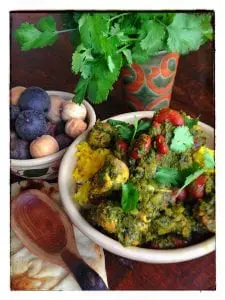By Joe Dizney
As admirable as it is to have a healthy respect for American foodways and local bounty, sometimes what’s called for is a culinary adventure, a break from the ordinary: dis-comfort food, if you will, something a little off the beaten track. Exploring new herbs, spices or culinary combinations keeps things interesting in the kitchen, on the table and in life.
But such detours from the routine don’t have to be complicated, expensive or a chore. The basic ingredients of most recipes are reasonably universal and mutable within reason across international cuisines.
Take for instance the exotic sounding ghormeh sabzi, a recipe said to be “the national dish of Iran.” Linguistically, ghormeh is Persian for “stew,” while sabzi translates as herbs — what this adds up to is herb stew, nominally a pretty basic idea.
Among the many variations, the main ingredients are a mixture of herbs and greens — mainly parsley, leeks or green onions and coriander (cilantro) in quantities greater than any single dish you’re probably familiar with.
Regional interpretations will accommodate any dark or bitter green — spinach, kale, mustard greens, turnip greens — and in addition to (or in place of) the cilantro, herbs can include dill, mint or tarragon. This basic mixture of greens and herbs is sautéed (or, as is usually specified, “fried”) then stewed with kidney beans — or yellow split-peas or black-eyed peas—and turmeric-seasoned yellow or red onions. Chicken, beef, lamb or heartier vegetables provide additional protein and bulk.

But the two defining ingredients — dried preserved limes (limu omani) and fenugreek leaves — are essential keys that unlock the distinctive flavors of the dish.
Limu omani are limes preserved by being boiled in brine and dried in the sun until hard. (They are identified as “black” or “white,” based vaguely on color, but are essentially the same.) Limu omani are intensely flavored — slightly sour earthy, bitter and smoky and extremely fragrant — like citrus on steroids. Fresh lime juice is an acceptable substitute, but pales in comparison.
Fenugreek (fenum graecum, “Greek hay”) is an annual herb and member of the pea family: the seeds, sprouts and leaves (both fresh and dried) are used in most eastern Mediterranean cuisines for their sweet-bittersweet, slightly caramel flavor. Hard to describe, but once experienced, the fragrance and flavor of fenugreek is immediately identifiable in Greek, Indian, Moroccan, Persian and Turkish Indian cuisines. (It is an essential ingredient in most Indian curries.) There is no replacement.
Dried fenugreek leaves can be found locally at Saraswati Grocery, an Indian spice store at 1299 Route 9 in Wappingers Falls (845-297-9203), which can be a colorful field trip in itself.
The dried limes are harder to find but both ingredients are readily available — and this is where a real adventure comes in — from Kalustyan’s (123 Lexington Ave. at 28th St. in New York, call 212-685-3451 or online at kalustyans.com). Kalustyan’s is a New York City institution and virtual spice museum, well worth a visit for the experience of its two full floors of culinary exoticism.
You can, of course, get anything you want from Amazon.com, but how off the beaten track is that?
Persian Herb & Bean Stew (Ghormeh Sabzi)
1 bunch flat-leaf parsley (reserve some for garnish)
1 bunch cilantro (reserve some for garnish)
About 12 medium scallions, green and white parts, root ends trimmed
3 tablespoons canola oil
1½ pounds boneless, skinless chicken thighs, cut into 1-inch cubes
Kosher salt and freshly ground black pepper, to taste
1 tablespoon ground turmeric
1 large yellow onion, finely chopped
4 cups chicken stock
1 tablespoon dried fenugreek leaves
5 dried Persian limes (limu omani) or ¼ cup fresh lime juice
Two 15-ounce cans kidney beans, rinsed and drained (I suggest Goya brand)
Cooked Jasmati or Persian rice, for serving
Pita, for serving
In the bowl of a large food processor, pulse-chop to fine the scallions, parsley, and cilantro. (Remember: you can use the parsley and cilantro stems which add a lot of flavor, but don’t over-process — you want a fine textured mince but not a paste.)
Season the chicken with salt and pepper. In a large pot or Dutch oven, heat the canola oil over medium-high and add the chicken. Cook, turning as needed, until browned on all sides, 8 to 10 minutes. Using a slotted spoon, transfer the chicken to a plate and set aside.
Add the yellow onion and turmeric to the pot and cook, stirring often, until softened, 5 to 6 minutes. Add scallions, parsley, cilantro and fenugreek leaves; cook until greens are wilted (about 5 minutes). Add chicken stock and dried limes; bring back to a medium simmer for 5 to 10 minutes.
Return chicken to the pot and bring all back to a low simmer. Cook uncovered until chicken is tender and liquid has reduced (about 25 minutes total). Halfway through cooking, pierce three limes with a paring knife; continue cooking for the full 25 minutes.
Add kidney beans and cook until warmed through (about another 5 minutes). Serve in bowls over white or Persian rice; garnish with parsley, cilantro or a spoon of plain yogurt with pitas on the side.
Vegetarian Options
Substitute vegetable stock for the chicken stock; omit the chicken and substitute 1½ lbs. of waxy potatoes and/or squash, cut into 1½ inch chunks, added to the greens when the chicken would have been. A cup or two of roughly chopped spinach added when the beans go in might be nice too, in either version. Other suggested vegetarian additions are quickly sautéed or roasted mushrooms or tofu.

